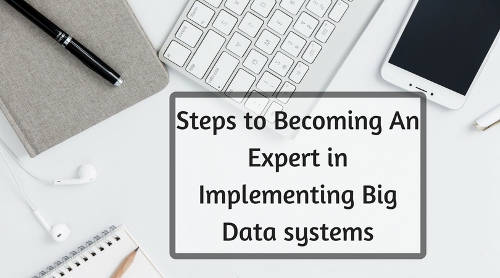Let’s look at the steps you can take to make sure there’s no mistake in your implementation of the Big Data systems:
1. Gather business requirements before gathering data
This goes without saying. If you’re talking about implementing Big Data solutions in an organization, let’s tell you that the amount of data with the organization will be way more than you can imagine. So much so that searching through the terabytes of data without knowing what you’re exactly looking for will cause more troubles in the long run than you can imagine at this moment in time. The implementation of any Big Data system should always commence by gathering, analyzing, and understanding your business requirements. It’s the most critical step in the whole process. You should always align Big Data projects with specific business goals, and not implement them just for the sake of it.
2. Look at Big Data implementation from a business perspective
Implementing Big Data requires a level of technical expertise, but we’re not talking about that here. The implementation of any Big Data system should always be seen from a business perspective, and not from the IT/Engineering end. Big Data demands IT to change their model from “develop it, and they’ll use” to “develop solutions apt for defined business needs.”
3. Use Agile and Iterative Approach to Implementation
Implementing Big Data is no mean task, and there are always sources of errors. Any Big Data project starts with specific use-cases. Over the course of the implementation, the needs and demands might evolve, as the organizations start to make sense of their data. Using agile or other iterative techniques instead of a “big bang application development” approach will ensure that you do not miss out on any demands.
4. Evaluate data requirements
It’s always advised to carry out a full evaluation of the data that comes into your business and how can it be used for your benefit. This step requires inputs and insights from your business stakeholders. Together with the other teams, they analyze what data needs to be retained, managed, and made accessible, and what data can be discarded.
5. Ease skills shortage with standards and governance
There is a growing shortage of professionals who can manage your Big Data. The best way to overcome the skills issues is by standardizing Big Data efforts within an IT governance program. There are various online courses to upskill you and your organization in Big Data. One of the most useful Big Data courses is the one offered by UpGrad.
6. Optimize knowledge transfer with a center of excellence
A CoE (center of excellence) will help you share solution knowledge, plan artifacts, and ensure oversight for projects. It can also help minimize mistakes by identifying them before they’ve occurred. Another benefit of the CoE approach is that it will continue to drive the big data and overall information architecture maturity in a more structured and systematic way.
7. Plan your sandbox and look for Cloud storage
Analytical sandboxes should be created on-demand, and resource management needs to have control of the entire data flow, from pre-processing, integration, in-database summarization, post-processing, and analytical modeling. A well thought out cloud provisioning, and security strategies play an integral role in supporting the changing requirements. The advantage of a public cloud is that it can be provisioned and scaled up instantly.
8. Associate big data with enterprise data
To unleash the value of big data, you need to associate it with your enterprise application data. The new capabilities established by companies should build on their prior investments in infrastructure, platform, business intelligence and data warehouses.
9. Embed analytics and decision-making using intelligence into operational workflow/routine
To achieve competitive advantages, you need to perform “analytics” the way you perform business; analytics needs to be a part of the corporate culture. The competitive advantage of data-driven organizations lies in how much sense they can make of their data on a day-to-day basis. Analytics need not be left to silos of teams, but rather made a part of the day-to-day operational function of front-end staff.
Following the above-discussed steps will help you seamlessly implement Big Data solutions in your organization in a methodical and systematic manner.








